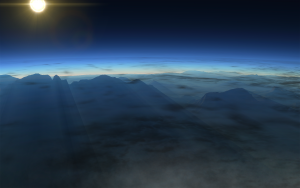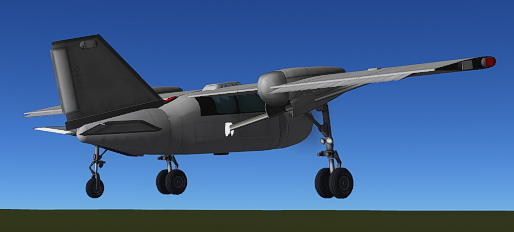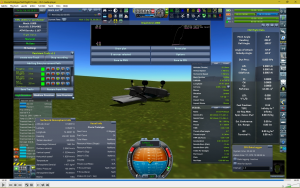|
Preliminary Crash Report for C7 Civvie Prototype
It’s been a busy week for our aircraft partners over at C7 Aerospace Division following the crash of the Civvie prototype during its first flight trial at the beginning of this week. Before we get to details involving the crash we should look at how the Civvie performed in flight, because fly it did despite worries that it might be too heavy as the airframe was built very strong to handle any problems during flight or landing that involved the ground.
The takeoff roll was performed at full throttle, taking 43 seconds and just under 2km to achieve a rate of positive climb @ 58m/s, although a small 3s hop just prior to takeoff did occur due to a bump in the turf. Flaps were set at 2 notches for takeoff and raised after positive climb was confirmed. Still at full throttle, Commander Val was able to establish and maintain a climb rate of 5m/s all the way up to 1km ASL with speeds ranging from 60-65m/s. During the climb she attempted to maintain a heading of 270 but even slightly adjusting the roll of the aircraft produced a great deal of sideslip, as much as +/- 5°, that slewed the aircraft slightly off course. Overall control in a westerly direction was maintained. Upon reaching 1km ASL she leveled off and conducted a gradual left turn of 15-20° back towards KSC, attempting to maintain altitude. Upon initial roll to the left a large slideslip was recorded of +/- 15° but Val was quickly able to properly coordinate the turn with her rudder and came about facing KSC still at 1km ASL, when she cut throttle completely to prepare for landing. Descending at 5m/s speed increased to over 70m/s and 1 notch of flaps were deployed. Falling below 700m ASL descent rate was increased to 10m/s and flaps notched to 3 (maximum). At around 300m ASL Val realized she was not well-aligned with the runway and attempted to correct her course with some large banking maneuvers over 20°, which also introduced a large amount of sideslip that was not properly corrected. Eventually these maneuvers oscillated into a sideslip so great it yawed the aircraft almost completely around at about 4m AGL, which caused airflow under the tail to flip the Civvie over and land upside down on the ground just south of the runway edge.
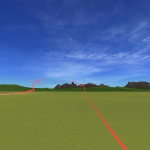
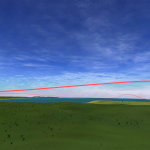
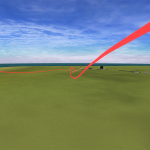
Various views of the Civvie’s 28km flight path
Post-analysis of the crash so far shows that although the Civvie’s extra-tough construction did its job in keeping the airframe intact and preventing Val from being crushed upon impact, she was still very lucky in that the large slew and flip-over dropped her speed from a bone-crushing 70m/s to a still bruising but survivable 44m/s. The impact force was just over 4Gs. The tail of the Civvie was bent upon impact and the right wing was also deformed as the aircraft slid along the ground and it dug into the incline of the runway, spinning the craft roughly 90° to its final resting position. The engine was almost completely destroyed as the nose was the first to impact the ground, which also crumpled and absorbed most of the shock.
The final decision as to whether this event was a cause of pilot error, design error or both is still under review. Crash investigators have yet to interview Commander Val, who was just today put back on active duty after spending the week recovering from her injuries, which only involved heavy bruising from her straps and a slight knock to the head. A complete check on the Civvie’s airframe and systems is also still underway in the HAB. We expect to hear more, if not a final verdict, sometime next week. We’re just happy Val is okay!
Progeny Mk2.1 Continues Readiness for Launch
The VAB crew has already begun assembling the first stage Mk1-A boosters with their new decoupler units and also readying the payload sections of the rocket. 3 rockets are being assembled simultaneously, although the fins on two are only being loosely attached so they can be adjusted as necessary for later flights based on the performance of the original design. The new and improved Mk1-B boosters are due to arrive next week so they can begin getting assembled and integrated as well. Overall, Simon says everything is on track for early next month and we’re excited to get back to launching!
KerBalloon Launch Updates
Since we’ve been unable to launch any rockets this past month, our KerBalloon program has been the main source of income for us. At the beginning of the month we received 10 additional units, our largest order to date, and so far we have used all but 3 for various clients to gather pressure and temperature data in the region around KSC. Launches have occurred both on land and sea, with support from the Maritime Service Vessels.
One unit was used to test our Mk1-B booster theory in the destruction of the Progeny Mk2 and because we couldn’t spare a parachute or had any way to attach it, the unit itself just floated up and burst as normal then came crashing back to the ground. KerBalloon took note of this design oversight and now has given us the option to attach parachutes directly to the balloon casing itself.
Another launch worthy of note was a recent deployment at sea which sank upon landing. The KerBalloon unit cases are designed to be buoyant, so no additional flotation devices are needed. We are still unsure of exactly what happened to cause the payload to sink as the recovery vessel did not witness the splashdown, it only arrived at the last transmitted location to find nothing. While partially equipped for salvage operations, scans of the sea floor did not turn up anything conclusive, as it is very rocky down there and scan resolution was not great enough to pick out the probe from the scatter. We examined the remaining units for any flaws that might have contributed to the sinking but did not uncover any. Unfortunately this mystery may never be solved, although we’ve mandated stricter recovery operations for water landings in the hopes of catching one sinking in action if it does occur again.
Finally, we got tired of not having photos of these balloon flights and while we still don’t have great camera technology we managed to strap on two basic cameras with only 30° field of view and send them up in lieu of science instruments. The photos they returned with were pretty amazing – click the photo below for an album of the best ones.
Celestial Snapshot of the Week
While Val was recuperating Bob was borrowing her telescope for some skygazing and managed to catch a very tight view of Jool with Tylo transiting and Laythe & Vall also in the picture. An interesting thing about this photo is that although the size of Laythe would make you think it’s closer to us then Vall, the opposite is true, and it’s just the fact that Laythe is nearly twice the size of Vall that it looks closer.
 From the Desk of Drew Kerman
From the Desk of Drew Kerman
Out of Character Behind the Scenes stuffWritten on 10/17/16
It’s been a week since v1.2 has arrived and things are looking pretty good already from a mod standpoint:
305 mods used
120 (39%) updated to v1.
232 critical mods remain
That’s not too shabby if you ask me. Being up and running completely on v1.2 within a month would be beyond my initial expectations. Some of the most worrisome updates, like RemoteTech, have already happened even, and other stuff like FAR and KSPRC have been announced as being worked on. So it’s just sitting back, waiting and watching for new updates to hit every day.
But let’s talk about the Civvie flight, which for a while I was afraid I would not be able to do under v1.1.3 because of the wheel physics. I could not get the aircraft to takeoff with the wheel configuration as shown to the public without it wobbling side to side and flipping out at around 30m/s. I checked the design numbers in the FAR analysis window and even posted on the forums about it and confirmed it was a wheel issue not a FAR issue. Finally I got a takeoff without control input using this configuration:
Those are medium-sized gear tweakscaled down and the small-sized gear used for a tailwheel. This setup matched the same angle of the aircraft at rest on the ground that the trike fixed gear setup achieved. I eventually realized it was just the tail wheel that was causing the trouble, and could have ditched the medium gears for the fixed gears but I chose not to, because having the medium gears on the wings made the aircraft more unstable but still controllable, which ultimately led to Val’s crash. I didn’t want to crash, I really did want to land the aircraft, but the likelihood of a crash happening without me intentionally crashing increased thanks to the gear on the wings. This was ultimately a good thing as it let me slow things down and lengthen the pace of development while I focused on the v1.2 release and the loss of KerbalMaps.com.
Also some insight into the details behind the report you read at the start of this entry:
I record everything with Fraps and then save it as a Divx file for much smaller size. So it’s very easy to go back and analyze things in detail. You’ll also notice the sky is not the sky you would see using Scatterer and EVE, because I don’t have any visual enhancements running when I do actual flights, for performance reasons. So how did I achieve a photo like the one showing the aircraft on takeoff? VesselMover combined with AirPark lets me place the craft at a height and orientation of my choosing, which was along the path generated by PersistentTrails so I can take a good photo that would hold true to the original flight conditions.







